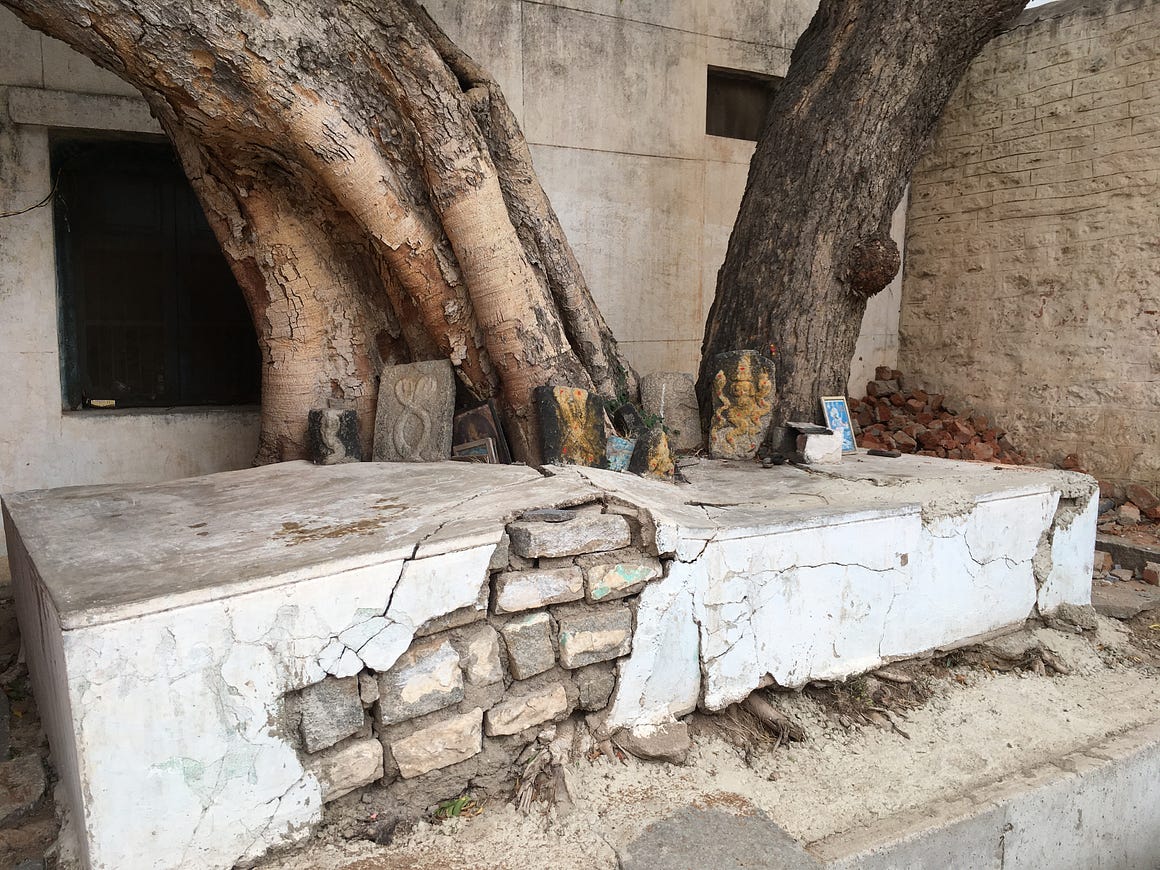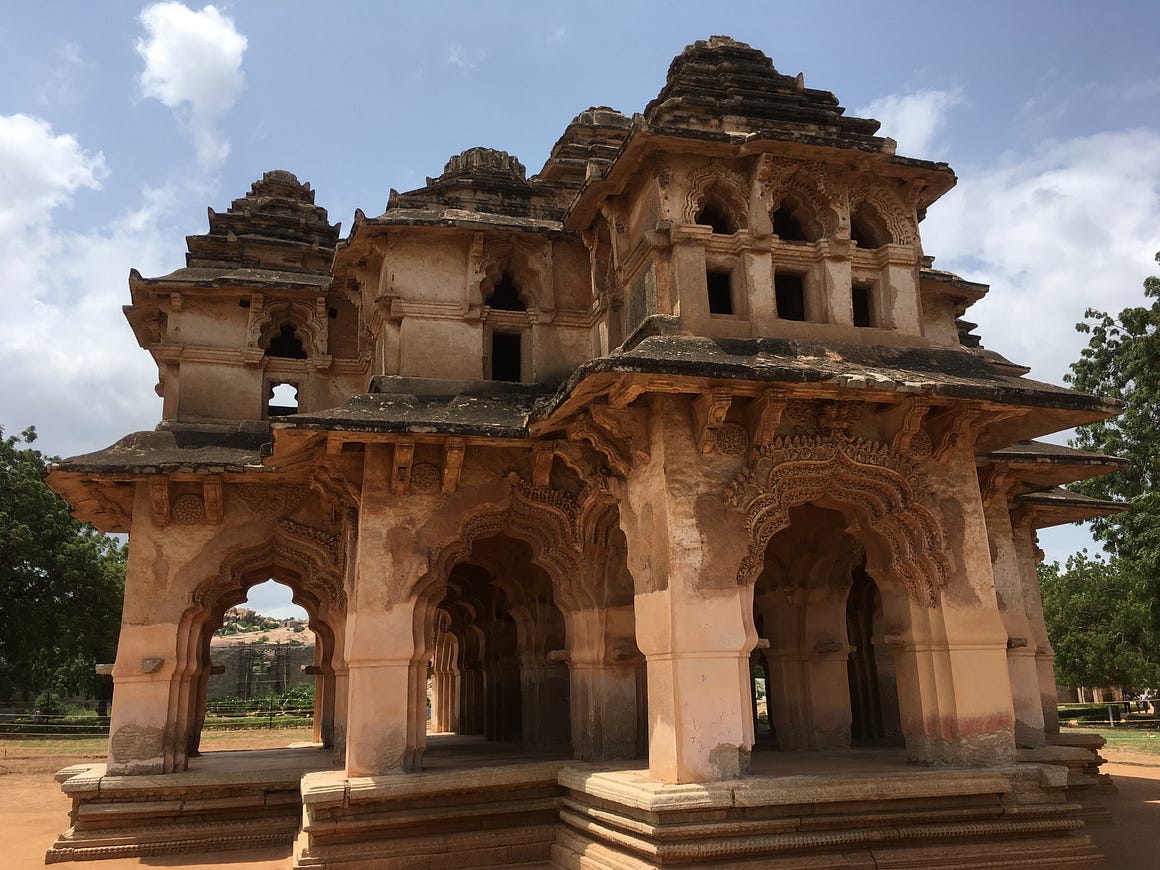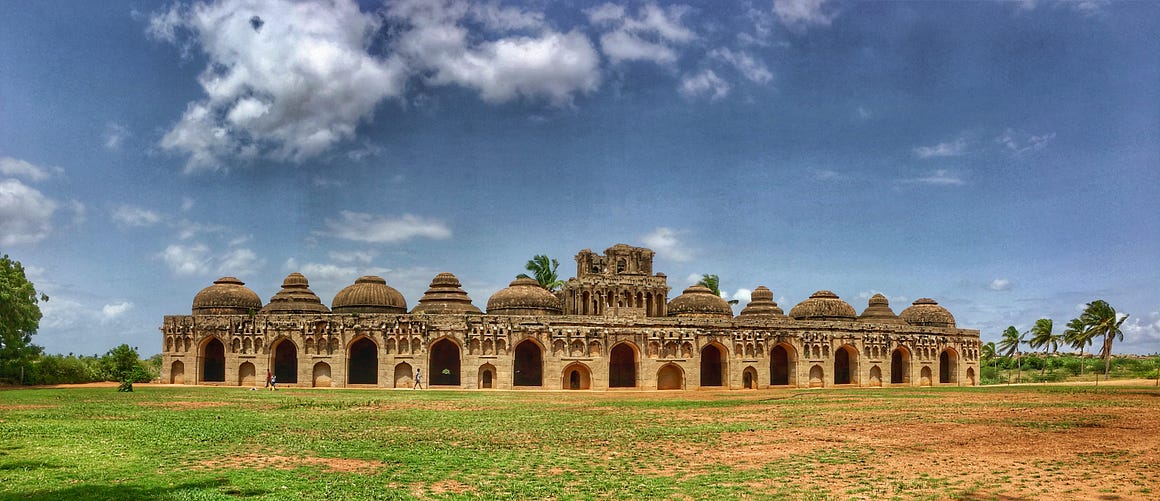Hampi: A brief unseasonal tourist guide
Published at: August 9th, 2018
Author: Chelsea McGill
This article was originally published on medium.com by Chelsea McGill
Thiruvengalanatha Temple near Kamalapura outside the ticketed area (Photo: Tathagata Neogi)
My husband Dr. Tathagata Neogi and I visited Hampi in late July 2018 as part of a backpacking trip in the Deccan. This is the first of a series of blogs we will be posting about the places we visited and the things we saw, writing as both travelers and as specialists in history, archaeology, and anthropology. This post concerns the practical aspects of staying, traveling, and eating in Hospet/Kamalapura/Hampi.
Visiting Hampi in late July was ideal. It was around 25℃ every day, with some sun that was not too intense. There was a lovely breeze, particularly when perched on top of the boulders and hills that make up most of the archaeological site. Despite the beautiful weather, there were almost no other tourists, which let us visit the sites mostly by ourselves. We recommend visiting the sites during the early morning or late afternoon, when the light is perfect and the sun is not too hot.
Room and Board
We stayed at Clark’s Inn in Kamalapura, about 4 km away from Hampi proper. We recommend staying in Kamalapura, where you can find both Clark’s Inn and the government guest house. The royal centre and other interesting sites are within easy walking distance of this village, and the archaeological museum is directly across the road from Clark’s Inn. Food is available in Kamalapura from the hotels (approx. INR 400/person for lunch or dinner at Clark’s Inn), as well as small roadside shops that serve tea (INR 10) and South Indian staples such as idly and poori. Although we did not try them, it would theoretically be possible to have vegetarian breakfast, lunch, or dinner at these places for around INR 60/person.
Hampi itself consists of a small, cramped, tourist area with expensive hotels/guest houses with minimal facilities, some expensive tourist-focused book and trinket stores, and a few restaurants. This area is crammed into the space between the main active temple complex (Virupaksha temple) and the river. We do not recommend staying in Hampi because (based on our pre-trip booking research) the prices for the hotels are nearly the same as the rooms in Kamalapura, but with fewer facilities. Since Kamalapura is also within easy walking distance of important sites, staying in Hampi provides no advantage, in our opinion.
Hampi does have one good restaurant, Mango Tree (approx. INR 200/person), which we visited during our exploration of the Sacred Centre. Tea (INR 10), bottled water, and snacks are available from shops near each of the major sites/temples, and by the river. Restrooms do not seem to be available in the shops or restaurants, but there is a paid public restroom (INR 10) near the entrance to the tourist area from the temple complex.
Transportation
We took a train from Hyderabad to Hospet, which hosts the nearest train and bus station to Hampi. We arrived in Hospet around 6:30 AM, and had some breakfast from the small snack shops outside the train station.
An auto directly from Hospet train station to Kamalapura is about INR 200–250. However, instead of taking an auto, we took a bus to Kamalapura. From the train station, we got on a bus to the Hospet bus station (INR 3), where we caught a bus to Kamalapura (INR 15). The bus ride was lovely, following the banks of a large tank and passing a few Vijayanagara-era temples and at least one small stepwell on the way. You can get down at the main bus stop in Kamalapura (in front of the Hanuman temple) or at Ambedkar Circle, which is slightly farther towards Hampi. While Ambedkar Circle is closer to Clark’s Inn, walking through the village from the main bus stop was a lovely experience. In particular, we enjoyed spotting the snake-carved Naga stones that are scattered throughout the village and continue to be worshiped.
 Naga stones in a shrine in Kamalapura (Photo: Tathagata Neogi)
Naga stones in a shrine in Kamalapura (Photo: Tathagata Neogi)
The archaeological site at Hampi is split into two major areas: the Royal Centre, near Kamalapura; and the Sacred Centre, near/in Hampi. It is best to take some form of transportation between these two centres, as it is a long walk with a significant gap between the two areas. This can be done by taking a bus from the bus stop in Kamalapura to Hampi Bazaar (price unknown), or by auto (INR 150).
Transportation within the site(s) is best done by foot, unless you have a restriction of time or mobility. In fact, it is often easier to move through the structures and ruins by foot, following the old roads or stairs, than it is to follow the newer roads. This also allows you to explore more of the site and to experience it in a way that is closer to how the people in Vijayanagara did. That being said, when we started to run out of time and energy we decided to take an auto to several specific places. From Hampi, we paid INR 600 to visit the ticketed area in the Royal Centre and the Vittala temple complex, after which he dropped us at the museum in Kamalapura.
 Vijayanagara-era road in the Sacred Centre near Hampi, outside the ticketed area (Photo: Tathagata Neogi)
Vijayanagara-era road in the Sacred Centre near Hampi, outside the ticketed area (Photo: Tathagata Neogi)
Something important to note is that autos are not allowed to enter the road that leads to the Vittala temple complex; your two options to travel the approximately 1 km road are to pay for transport in a golf cart (INR 20/person) or to walk. Despite being exhausted we decided to walk the route, which allowed us to see more of the bazaar area that leads up to the front of the temple. Had we known that autos were not allowed to approach the temple, however, we probably would not have visited the complex.
If you want to visit the areas on the other side of the river (i.e., Anegondi), the normal method of transportation is small round boats known as coracles. Unfortunately, when we visited the coracle transport was stopped for the monsoon, which seems to happen every year; locals recommended that we hire an auto to go there instead (we ran out of time and were unable to do so).
Tickets
 Lotus Mahal audience chamber in the Royal Centre, within the ticketed area (Photo: Tathagata Neogi)
Lotus Mahal audience chamber in the Royal Centre, within the ticketed area (Photo: Tathagata Neogi)
The Archaeological Survey of India has implemented a combined ticket for the three ticketed areas in the site: a small area in the Royal Centre that is surrounded by a wall and contains several excavated palace structures, watchtowers, tanks, the Lotus Mahal audience chamber, and a probable armory; the Vittala temple complex; and the Archaeological Museum in Kamalapura. Even though these ticketed areas are far from each other, the ticket is only valid for one day. It costs INR 500 for foreigners and INR 30 for Indian nationals.
 The Elephant Stables in the Royal Centre, outside the ticketed area (Photo: Tathagata Neogi)
The Elephant Stables in the Royal Centre, outside the ticketed area (Photo: Tathagata Neogi)
Because of the somewhat dilapidated state of the Archaeological Museum, the inconvenience of reaching the Vittala temple, and the amount of interesting buildings and ruins that you can see for free in Hampi, we recommend not paying to enter the ticketed areas unless you have finished seeing the rest of the site and have extra time.
Enjoyed this post? Follow The Calcutta Blog for more.